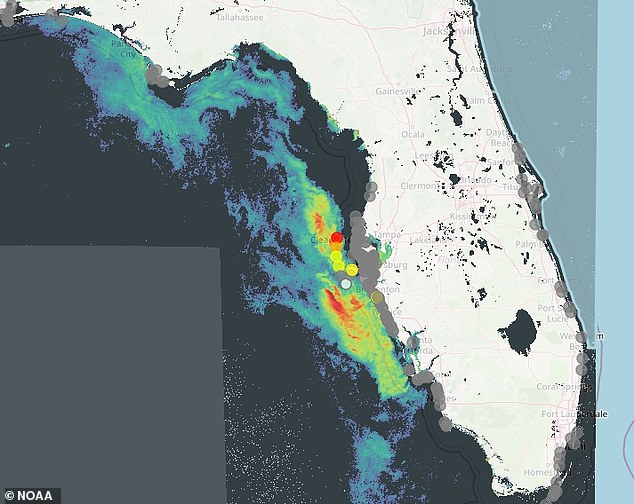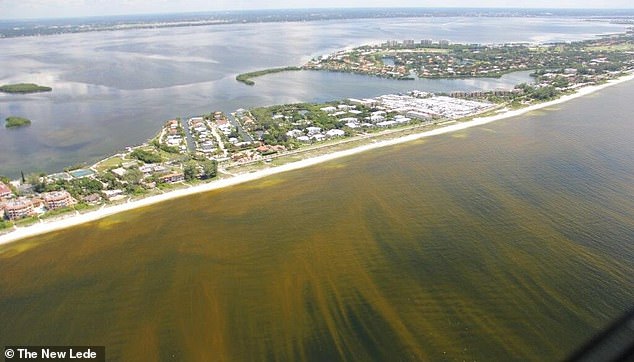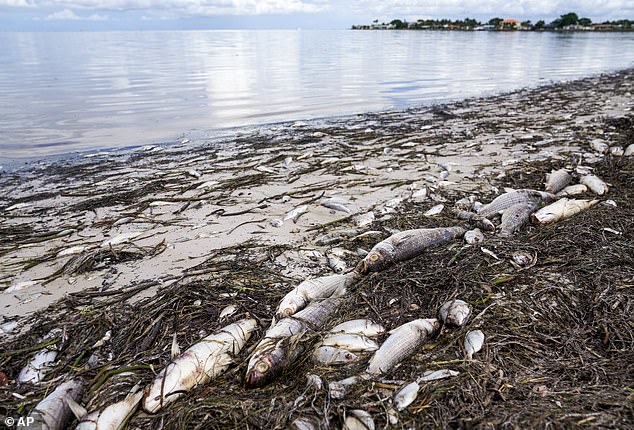Warning of the deadly ‘red tide’ that will hit Florida due to hurricanes
Residents of Florida’s Gulf Coast are facing yet another threat from back-to-back hurricanes: deadly “red tides.”
Water samples and satellite images have shown medium to high levels of Karenia brevis, the type of algae that causes red tides, off the coast of Tampa Bay.
Red tides occur when Karenia brevis grows out of control, turning the water reddish brown and producing a powerful neurotoxin that can be suspended in the air near beaches.
This toxin can kill fish and sicken people and pets with respiratory symptoms including shortness of breath, coughing and sneezing.
In extreme cases, inhaling red tide toxins can cause serious respiratory diseases such as pneumonia, bronchitis and worsening of asthma.
Red tides can become fatal when respiratory symptoms become severe, or when a person eats shellfish contaminated with these toxins.
This causes paralytic shellfish poisoning (PSP), which is fatal in about 8.5 percent of cases.
Red tides occur when Karenia brevis grows out of control, turning the water reddish brown and producing a powerful neurotoxin.
“Karenia brevis (red tide) is present along the coast at concentrations that may cause respiratory irritation during onshore winds in Pinellas and Sarasota counties,” The National Centers for Coastal Ocean Science (NCCOS) currently states.
‘A moderate to high risk of respiratory irritation is most likely when the wind is blowing onshore or along the coast, and less likely when the wind is blowing offshore.’
Red tide toxins cause symptoms similar to an “instant cold,” Richard Stumpf, an oceanographer with the National Oceanic and Atmospheric Administration (NOAA), told the Associated Press.
Symptoms typically disappear within minutes of leaving the infected area, he added.
But for people with asthma or other underlying breathing problems, symptoms can become severe or even require medical attention.
And some pets that have come into contact with red tide toxins have become seriously ill or died.
Red tides can also lead to mass deaths of fish and other marine life, leaving beaches covered in rotting carcasses.
For example, in March 2023, the red tide caused scores of dead fish to wash up on beaches along the Gulf Coast, especially in Sarasota and Pinellas counties.

NOAA satellite images show the location of an algal bloom containing Karenia brevis, also known as a red tide
The impact prompted organizers of the annual BeachFest in Indian Rocks Beach to cancel the festival, even though it was still more than a month away.
In Florida, red tide is most common in late summer and early fall, but researchers say This year’s threat was fueled by Hurricanes Helene and Milton.
Hurricanes do not cause red tides, but they can worsen existing harmful algae blooms.
The Florida Fish and Wildlife Commission reported medium and high levels of Karenia brevis concentrations in some coastal locations near Pinellas County between September 26 and October 3 – just as Hurricane Helene made landfall.
Hurricane Milton hit Florida shortly afterward on October 9.

A hurricane can bring harmful algal blooms closer to shore, sometimes pushing them hundreds of miles offshore
Tropical storms create nutrient-rich water that feeds algae.
They also produce a lot of rainfall, which can increase the amount of land runoff and therefore the amount of nutrients entering the water.
If a damaging bloom is already present when a hurricane hits, the storm can stimulate its growth and help form a red tide.
A hurricane can also bring harmful algal blooms closer to shore, sometimes pushing them hundreds of miles offshore, Stumpf said.
This increases the threat to human health, causing beachgoers and coastal community members to come into more contact with tide toxins
This red tide threat comes as Floridians are still recovering from the impact of back-to-back hurricanes.

Red tides can also lead to mass deaths of fish and other marine life, leaving beaches covered in rotting carcasses
Category 4 Hurricane Helene broke records along Florida’s west coast, causing more than 15 feet of flooding in the Big Bend region and up to 11 feet of flooding in other areas.
The hurricane lashed the state with winds of 140 miles per hour, causing permanent damage to homes, buildings and other infrastructure.
An estimated 20 Floridians were killed by the storm, which eventually moved up the East Coast and claimed a total of 215 lives in multiple states.
Still reeling from Helene, Florida braced for Hurricane Milton, which made landfall just two weeks later as a Category 3 storm.
Milton knocked out power to more than 3 million Floridians, bringing up to 18 inches of rain, a storm surge of 10 feet and wind gusts of more than 100 miles per hour.
This hurricane also spawned a plague of deadly tornadoes, which ripped through the state and caused significant destruction.
At least 24 people were killed by the storm, which only affected Florida.
